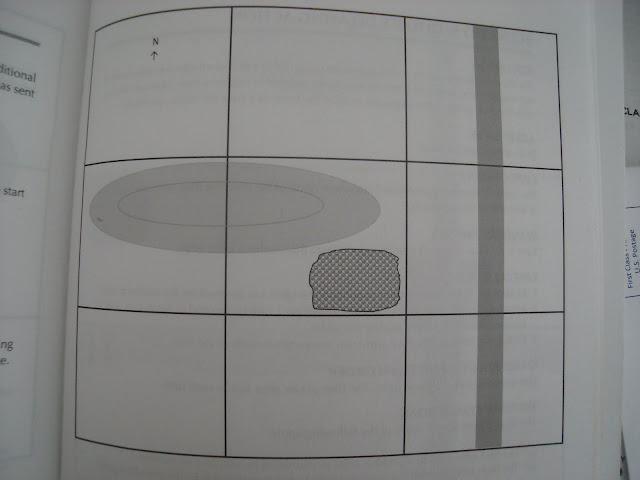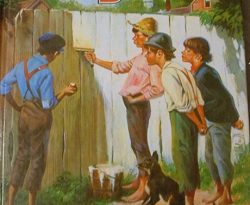Limited Woods Access
In all the early six sets of rules, access to the woods is provided by auxiliary Units that are only available in variable amounts of 0-2. No other Units are allowed to enter woods.
- If either Red or Blue has 1-2 and the other side has none, he is poised to exploit the wood to his advantage.
- If both have Skirmishers, then the wood becomes a combat zone, probably favoring Blue who will have more Units that can attack it faster; this happens with later period rules.
- If neither side has Skirmishers, then the wood becomes an obstacle to both movement and line of sight. Ultimately, this should help Red more than Blue since it slows down the attack.
Limited Firepower
In all the early six sets of rules, shooting is provided by auxiliary Units and the core 1/2-2/3 of the force is Infantry with no firepower or limited firepower [in Pike and Shot they can run out of ammo]. The best one can do is the Medieval rules, with two d6+2 Archers, I guess representing the best Crossbowmen or Longbowmen available. These can have a gatling-gun like effect if you don't introduce an ammo limit mechanic.
On to the Later Period Rules
Now we will advance in history to the last three sets of rules; American Civil War, WWI [called "Machine Age"] and WWII. There is now parity on both sides, i.e. neither is handicapped by having few or no Units that may occupy the wood. In fact, all three eras have as their basic Unit Infantry that provide solid firepower at D6 or D6+2 and are able to enter the wood.
The wood itself and the hill immediately behind are still, IMHO, the most crucial terrain pieces to control - they anchor the East hill flank while the board edge anchors the West flank. The wood blocks Line of Sight, especially important against Artillery and Mortars, and ATGs which are deadly to Tanks. However, if Red has Tanks, he may want to consider using one on the hill as Tanks in the WWII rules get a cover benefit of halved Hits due to being hull down upon the hill.

Given this situation of parity, the best attack largely depends on Red's selection of defending Units and if he chooses to occupy the wood. For reasons known only to himself, Red may choose to put two Artillery or Cavalry on the hill, or two Anti-Tank Guns or Mortars - support Units unable to occupy the wood and with various limitations in their effectiveness. Meanwhile, the force must be made up of 3-4 Infantry, which are the best to hold the hill if not always the best to attack it.
My thought is an attack from the East usually has the best chance of success. The three attacking Units mass to destroy at least one defender before the Red reinforcements arrive. If the wood is occupied by Red, then the Red Unit in the woods should be destroyed. If Red concedes the wood, then Red will gain at least a turn as he uses the Wood as his own screen from incoming Blue Units and their firepower, but loses the wood.
While Blue's seizure of the wood doesn't take the hill, it is a good start along with destroying one Red Unit. There will only be one Red Unit left on the hill as two reinforcements race to the rescue. Red's only alternative is to retreat the most damaged unit off the hill, out of Line of Sight, but it may permit Blue to actually get up onto the hill. Again, depending on how you handle line of sight, being on the hill may be dangerous as it can be seen by many Units.
Below, Red has ATG and Infantry Units on the hill [platoons, per the rule explanation]. Incoming will be three Blue Infantry Units, on the road. Depending on your rule mods, you may allow Red to dig these units in, or have an overwatch capability.

Red Player Turn 1, Red Infantry occupy the wood. Depending on your Line of Sight rules, they may be able to see and be seen. The tactic and the mechanic are largely up to the player. In my WWII rules, Up the Blue!, I require Units to be touching the edge for mutual unlimited LoS to distant enemy; but if within the wood the mutual LoS is limited to 3", or Close Range.

Blue Player Turn 1, Infantry advance as quickly as possible. A tank Unit here would be useful. Mortars are sometimes useful. The ability of Infantry to Spot for the Mortar becomes a critical part of the Line of Sight mechanic you decide to use.

Red Player Turn 2, Red Infantry open Fire. Depending on your rule mods, you may allow them to go into overwatch mode, or dig in instead. I offer both options with my rules. Here, they have set up on the edge of the wood where they get cover, which give them halved Hits, and are already within 12" their Range. Of course, the reverse is also true.

Blue Player Turn 2. Two Infantry in position. Under original rules, two turns of shooting will have one of these Units at almost 50% Hits given average rolls. It is possible for all of them to have deployed and shooting on Turn 2, just from farther away. This would cause about 10 Hits a turn, eliminating the Unit in the woods on Turn 3. I chose to advance a bit farther.

Alternative plan - end of Turn 2, with Blue moving to occupy the wood while Red remains on the hill, taking no Hits due to range and LoS issues.

Turn 3, Red and Blue infantry will get into Firing Range. Red reinforcements will arrive.

Alternative Turn 3-4, has Blue bringing in ATGs to block Red reinforcements. Red chose two Infantry for the hill, so if Blue had a Tank Unit, it would do nicely for a frontal attack supported by Infantry in the wood. There are numerous combinations, of course, and ATGs, Mortars and Tanks are all support Units, and none are guaranteed to be in your force altho you will have at least 1-2 types, any of which could be quite useful.

You may recall from last post that if Blue has a substantial Firepower advantage, a swift frontal attack from the South using the wood to secure his right flank is a good plan. Some examples might be Infantry attacking the wood while Tanks attack the hill with Mortar support. An unusual plan might have two Mortars supporting an attack by one Infantry against two Infantry or ATGs. Either of these can work as two Mortars can almost knock out a Unit every other Turn.
Modifications to the scenario are easily made. Key to the plan of both sides is the arrival of reinforcements. You may tweak or randomize the arrivals to keep this scenario fresh. The present arrival rates and forces available are:
- Turn 1: Red 2, Blue 3 Units. A 3-2 advantage to Blue until Turn 3 [2 Turns].
- Turn 3: Red +2 Units, a 4-3 advantage to Red until Turn 4 [1 Turn].
- Turn 4: Blue +3 Units, a 3-2 advantage to Blue until Turn 6 [3 Turns].
- Turn 6: Red +2 Units, both sides now equal.
The pressure is still largely upon Blue - Red starts with a won game and only has to keep it. A delay of Red's Turn 3 Units until Turn 4, and Turn 6 until Turn 8 [when they arrive next to the hill - a critical moment and location] will give Blue more time to invest the hill. As my overall experience is that the game is Red's to lose, this delay in Red reinforcements is worth trying for any fans of this scenario.
As a solo player, I recommend playing Blue as the reinforcements are decided at setup [the three you didn't deploy] and would present no surprise if you play Red. Red's schedule can be randomized by Unit or put down on two cards which are randomly drawn.
If you want more uncertainty, write all six red units down on separate flash cards, deploying two random hidden selections upon the hill, and two on the North Rd. and the last two as the West Reinforcements. Do not reveal them until you are in spotting distance - 12" in the original OHW rules, or they fire or move. You can then dice for the two main ploys I think are useful at the hill, whether or not to occupy the wood, whether or not to hide in the defilade of the hill from Blue firepower. Again, the last depends on how you define the hill - does it have a military crest? Or is it a plateau all around the edge. NT seems to imply a military crest with his diagram of oval 2-level hills, IMHO. So if taking 50% hits, Red might dice to pull that Unit back behind the crest.
The above issues will be largely the same for the American Civil War and WWI rules. Each will present Cavalry options, faster but with less firepower, and Artillery which is a bit weaker than Mortars but presents the same possibilities. The WWI Artillery are d6, so should inflict 6-7 Hits a turn on average if you get two of them; with an Infantry attack, at least one Red defender should be crippled or destroyed by Turn 3.
Conclusion
I hope that this analysis of Scenario #8 gives you some inspiration to play this and many other One-Hour Wargame scenarios multiple times with changes in force and some experiments with your terrain and miniatures collection. Many of the scenarios are quite simple to work with but have a lot of depth and provide numerous quick games each providing another lesson that increases understanding of tactics both within and across various periods of military history. Have fun and sharpen your brain!





















